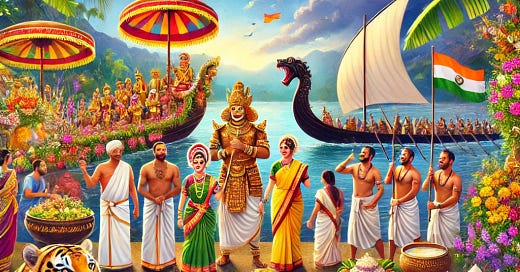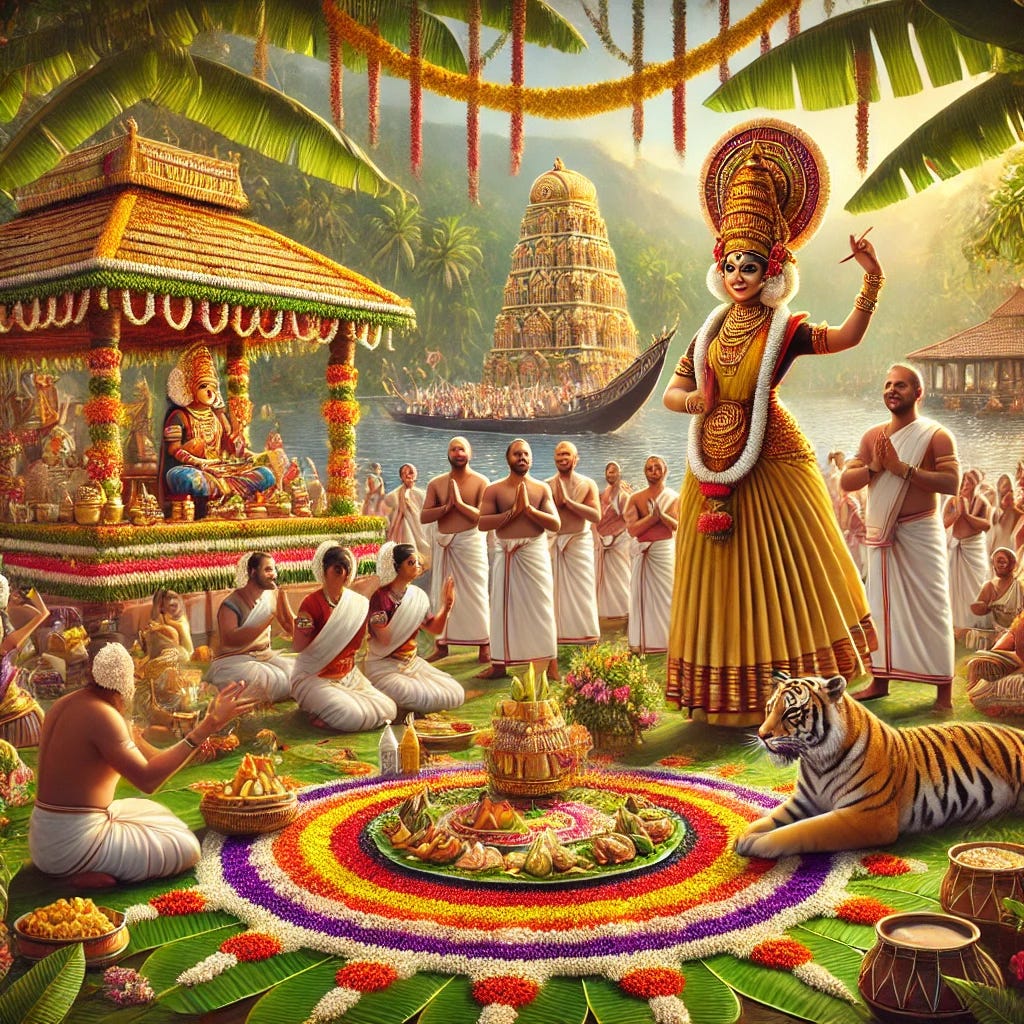Happy Onam: Celebrating Kerala’s Rich Cultural Heritage
A Grand 10-Day Extravaganza Embraced by All Faiths of Malayalam-Speaking Keralites, in Kerala and Beyond.
Happy Onam!
Wishing you all a very Happy Onam! As the vibrant festival of Kerala sweeps in with its ten-day celebrations, let’s take a moment to explore the story, traditions, and significance of this magnificent festival that transcends religious and cultural boundaries. While many in North India may not be familiar with the details of this Malyali festival, Onam stands as a glowing testament to the rich history, inclusivity, and spirit of unity in Kerala.
The Legend of Mahabali: The Heart of Onam
At the heart of Onam lies the legend of King Mahabali, a revered figure in Kerala’s folklore. Mahabali, or Maveli, was a benevolent demon king whose reign was marked by prosperity, justice, and equality. His governance was so exemplary that it caught the attention—and jealousy—of the gods.
According to myth, Lord Vishnu, taking the form of a dwarf Brahmin named Vamana, approached Mahabali during a sacrificial ceremony. The ever-generous king offered to grant him any wish. Vamana humbly asked for just three paces of land. As soon as Mahabali agreed, Vamana transformed into a gigantic cosmic form. With one step, he covered the earth, and with the second, the heavens. Realising the divine nature of Vamana, Mahabali offered his own head for the third step.
Impressed by Mahabali’s humility, Lord Vishnu granted him the boon to visit his beloved kingdom and people once a year. Onam celebrates this annual homecoming of Mahabali, symbolising the return of prosperity, happiness, and harmony to Kerala.
The Cultural Significance and Celebrations of Onam
Onam is not just a single day of festivity but a grand ten-day celebration, with each day having its own unique significance and rituals:
Atham: The festival begins with the raising of the Onam flag, and the creation of the first Pookalam (floral rangoli) to welcome King Mahabali.
Chithira: Homes are thoroughly cleaned and decorated to mark the festive occasion.
Chodhi: Families embark on shopping sprees, buying new clothes and gifts, an integral part of Onam celebrations.
Vishakam: Folk dance practices begin in preparation for grand performances.
Anizham: The thrilling Vallamkali (snake boat races) commence, a spectacle to behold.
Thriketa: Preparations begin to welcome Mahabali, with many households starting to finalise festive arrangements.
Moolam: Streets and homes come alive with major folk art performances.
Pooradam: Statues of Mahabali and Vamana are displayed, adding a spiritual touch to homes.
Uthradam: The eve of Onam is a day of last-minute shopping, feasting preparations, and cultural activities.
Thiruvonam: The grand culmination, Thiruvonam, is the day of the Onasadya, a lavish feast served on banana leaves, celebrated with joy and fervour.
Onam: A Festival of Secular Unity
While rooted in Hindu mythology, Onam is a festival that transcends religious boundaries. People of all faiths in Kerala—whether Hindu, Christian, or Muslim—celebrate this festival with equal enthusiasm. The secular spirit of Onam reflects Kerala's ethos of inclusivity and communal harmony. During this time, businesses, schools, and government offices close, ensuring that people from all walks of life can join in the festivities.
For Malayalis living outside Kerala, Onam is a significant cultural event, helping them maintain ties with their homeland. Communities across the globe come together, recreating the same atmosphere of unity and celebration.
Traditional Arts and Games: A Kaleidoscope of Kerala’s Cultural Heritage
Onam is not just a festival of myth and food but a vibrant showcase of Kerala’s rich cultural traditions. The streets come alive with various traditional performances and games:
Pulikali: Performers, painted like tigers and hunters, enact a thrilling dance that entertains both young and old.
Kummattikali: A colourful mask dance that depicts ancient tales and characters from folklore.
Thumbi Thullal: A graceful women’s dance form, showcasing the elegance of Kerala's traditional art.
Onathallu: A martial art form performed in the spirit of celebration and competition.
Onavillu: A symbolic bow-and-arrow performance that draws large crowds.
In addition, traditional games such as Talappanthukali (a ball game), Ambeyyal (archery), and Kutukutu (a form of kabaddi) bring families and communities together in friendly competition.
The Culinary Extravaganza: The Onasadya Feast
Onam is synonymous with the legendary Onasadya, a grand feast featuring a multitude of vegetarian dishes, served on a banana leaf. From tangy pickles and spicy curries to sweet payasams (puddings) and crispy banana chips, the feast is a gastronomic delight. The Onasadya typically includes around 26 different dishes, all of which reflect Kerala’s diverse and rich culinary traditions.
Onam’s Economic and Social Impact
Beyond its cultural significance, Onam is a major boost to Kerala's economy. The festival season witnesses an explosion in consumer spending, with people buying clothes, gifts, and festival essentials. Artisans and craftspeople find a platform to sell their wares, and traditional artists have an opportunity to showcase their skills.
Many Malayalis working abroad also return home during this period, adding to the economic activity. The influx of expatriates brings joy to families and strengthens social bonds, while also contributing to Kerala’s hospitality and retail sectors.
The Allegorical and Spiritual Significance of Onam
Beyond the vibrant festivities, Onam carries deep allegorical and spiritual significance, offering timeless lessons in humility, equality, and the transient nature of power. The story of King Mahabali and Lord Vishnu’s Vamana avatar serves as a metaphor for the cyclical nature of life, reminding us that no matter how powerful or prosperous we become, humility is paramount. Mahabali’s willingness to offer his own head to Vamana reflects the ultimate spiritual surrender, a reminder of the selflessness and sacrifice required to transcend material success.
Onam, in this light, is not just a celebration of a king’s return, but a celebration of virtues like generosity, humility, and the realisation that true greatness lies not in wealth or power, but in serving others and staying connected to one’s roots. This philosophy resonates deeply in today’s world, where the festival encourages people to reflect on their inner values and the importance of unity and harmony in society.
Summing Up: Onam, a Timeless Festival of Unity
Onam is more than just a festival—it’s a celebration of Kerala’s values of unity, inclusivity, and cultural richness. It intertwines mythology with secular celebrations, bridging religious and social divides. Despite the challenges posed by modernity and globalisation, Onam continues to preserve Kerala's rich traditions while remaining relevant to the younger generations.
As the legend of King Mahabali reminds us, prosperity, generosity, and humility are timeless values. Onam’s celebrations bring the entire state—and its diaspora—together, fostering a sense of community, mutual respect, and shared cultural heritage. Through its vibrant dances, sumptuous feasts, and heartfelt festivities, Onam embodies the spirit of Kerala: one of diversity, progress, and deep-rooted tradition.





